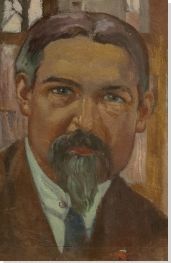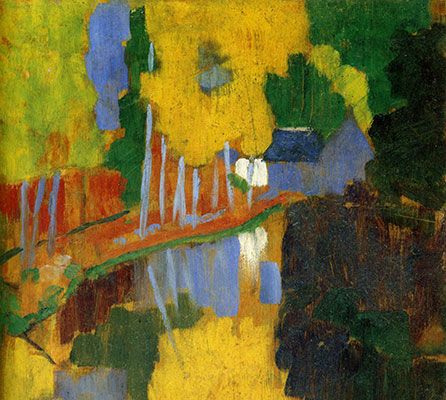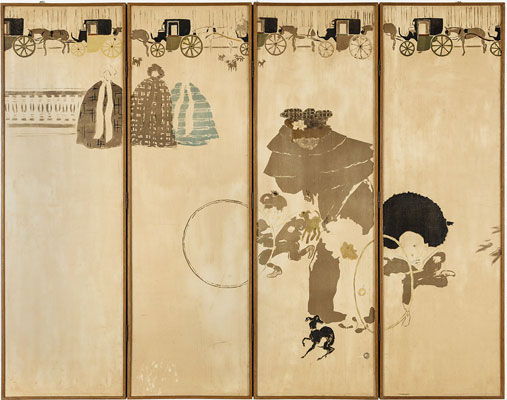Summary of Maurice Denis
Maurice Denis is perhaps unique amongst avant-garde French painters of the late-nineteenth century in combining a strong commitment to formal and stylistic innovation with an equally profound sense of the significance of tradition: in art, culture, and, perhaps above all else, religion. His boldly colored, vibrant paintings, like those of the artists with whom he is generally grouped together - Paul Sérusier, Pierre Bonnard - express a commitment to abstraction, and to relaying the inner life of the soul, which is, at one level, quintessentially modern. But unlike his peers, the soul which Denis sought to express was integrally shaped by his religious faith which can already be sensed from his earliest paintings as a member of the Nabi group which he co-founded in 1888, and which would lead him, later in life, to activities such as church renovation and altarpiece design. By the end of his life, Denis was also renowned as an art critic, having produced a series of influential essays on aesthetics and spirituality.
Accomplishments
- Along with Paul Sérusier, Pierre Bonnard, and others Denis founded a group called "Les Nabis". whose ideas defined many of the most significant stylistic advances in modern art during the late nineteenth century. Breaking away from the emphasis on naturalistic representation of visual sensation which had preoccupied French painting since Impressionism, they focused on using bold, clearly defined blocks of color to express the inner life of their subject-matter. Though Sérusier and Bonnard are perhaps the best-known painters associated with this school, it was Maurice Denis who became their most eloquent spokesperson, laying down the ideas which united their approach in his 1890 manifesto "Definition of Neo-Traditionalism".
- Denis's work from the mid-to-late 1890s onwards became increasingly defined by a more figuratively accurate, rigorous compositional style than had defined the early work of the Nabis. Initially turning to the example of Paul Cézanne - whom he hailed as the prophet of a new Classicism - to characterize his newly solid, modelled compositional style, Denis would increasingly find the inspiration for his "Neo-Classicist" approach in the art of the Italian Renaissance. In combining an engagement with the most significant recent advances in modern art with a sense of the broader historical sweep of European painting, Denis stood for an interplay of revolution and continuity in artistic style which sets his oeuvre apart. He is an example of that rare category of modern artist who views themself, first and foremost, as a guardian of tradition.
- Known as the "Nabi of the Beautiful Icons" because of the beauty and spiritual intensity of his work, Denis's painting was informed by his Catholic faith early on. From religiously inflected works of the early Nabi period such as Le Mystère Catholique (1889) onwards, the spiritual overtones of Denis's art became more and more pronounced until, by the 1910s, he viewed himself above all else as religious artist. These concerns found fruition in his formation, in 1919, of the Ateliers d'Art Sacré ("Workshops of Sacred Art"), a group dedicated to the renovation of churches and cathedrals, to the design of altarpieces and murals, and to training the next generation of church craftsmen. Denis was unique amongst painters of his generation in combining a commitment to formal innovation with a traditional religious faith. As such, during the later part of his life, he fundamentally redefined the stylistic possibilities of religious art.
Important Art by Maurice Denis
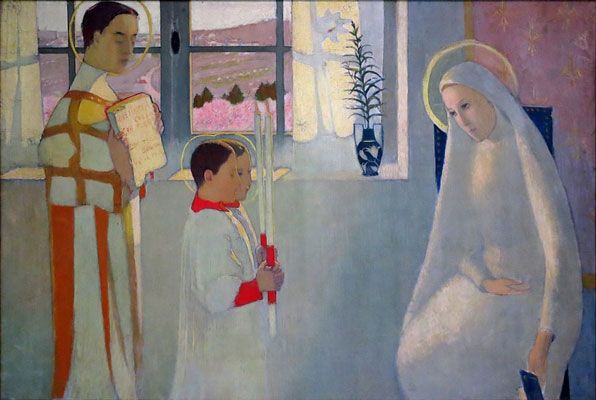
Le Mystère Catholique
Painted when Denis was just 18 years old, this work depicts a Catholic ceremony celebrating one of the Christian mysteries, the appearance of the Angel Gabriel to the Virgin Mary. It shows two children carrying large candles, a woman clothed in white whose head is framed by a golden aureole, and a priest holding a copy of the Bible. Denis explored this subject across six different works, this painting, from 1889, being the second and most famous of them. In composing this piece, Denis arrived at a new synthetic language for his art, the precursor of the visual vocabulary which he would continue to refine across the remainder of his life.
The painting offers a deeply personal vision of the Annunciation, which is reenvisaged in a conspicuously modern context, the altar boys and priest symbolizing the angels, the lissom lady in white as the Virgin Mary, her hand resting suggestively on her stomach. The painting's dreamlike colors, and the otherworldly delicacy and grace of the figures, emphasizes the spiritual content of the scene. These qualities partly take a cue from the new collective approach of the Nabis. At the same time, we can sense in the painting's color-palette the influence of the early Renaissance painter Fra Angelico, one of Denis's artistic masters, who had composed a famous Annunciation scene for the convent of San Marco in Florence. In Fra Angelico's work, Denis noted, "lighting is diffused", "daylight is white", and "shadows are non-existent" - we can see similar tonal affects at work in his own painting.
Le Mystere Catholique is, amongst other things, a significant early example of the work associated with the Nabis, who abandoned the Post-Impressionist concern with naturalistic recreation of visual sensation - a concern most strikingly borne out in the Pointillism of Suerat - in favor of vibrant colors and figurative abstraction which would capture the sensual and emotional content of the subject-matter. At the same time, the painting shows the deep religious belief which informed Denis's art from the earliest phase of his career - his sense that art should "celebrate all the miracles of Christianity" - which would later place him at odds with many of the most significant developments in modern art.
Oil on canvas - Saint-Germain-en-Laye, Musée Départemental
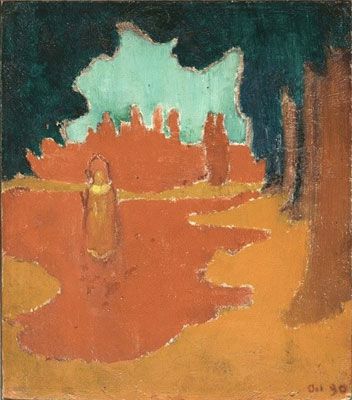
Sunlight on the Terrace
At first glance, this painting seems to consist of various amorphous patches of color - red, blue, black - faintly outlined in white, and devoid of obvious figurative content or implied three-dimensional form. However, the title guides the viewer to interpret the work as showing a sunlit terrace: more specifically, the painting depicts the seventeenth-century terrace of the Chateau de Saint-Germain-en-Laye, where Denis was living at the time of composition. The light of the sun appears as a monochrome patch of bright red on orange ground, the tree leaves as a single, dark green shape, the sky as an enclosed patch of blue. Blobs of red, blending in with the red of the sunlight, reprsent a group of figures in the background; one form, perhaps female, stands out in orange in the foreground.
This work is an early product of Denis's Nabi period. As such, it seems to put into practice a statement from his famous "Definition of Neo-Traditionalism", published the same year: that a painting is, before anything else, "a flat surface covered with colors arranged in a certain order". Like all the Nabi painters, Denis was a fervent admirer of Gauguin, and this piece's emphasis on pure color is a clear nod to the master, though this influence is combined with a number of others. The choice of colors, for example, and the organic shapes, also generate a curious, proto-Expressionist intensity reminiscent of the work of Symbolist painters such as Odilon Redon. The influence of Japanese woodblock prints is clear from the extreme flatness of the composition, and in the use of a small number of clearly distinguished shapes.
Sunlight on the Terrace was never exhibited, as Denis considered it the document of an experiment rather than a finished work. In retrospect, however, it seems to predict the movement towards a purer, more extreme form of abstraction which would characterize a whole range of post-Nabi art in France, perhaps especially the Fauvist paintings of Matisse and others. As regards Denis's own artistic development, this painting seems to point to a possible movement towards extreme abstraction which Denis would not, in fact, follow through on.
Oil on card - Musée d'Orsay, Paris
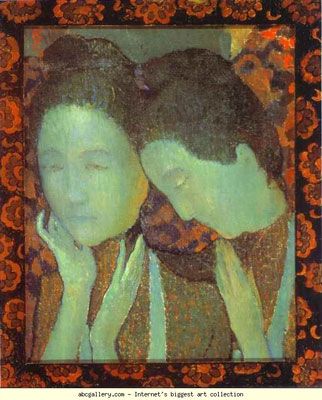
The Two Sisters
The two sisters shown in this painting are depicted in an abstract, stylized manner, their facial expressions greatly simplified, their hair pulled up in buns, their fingers elongated; surrounding them is a decorative, floral border which, in true modernist style, is integrated into the main body of the painting itself.
The appearance and body language of the women alludes to the movement of Japonism -engagement with the art and design traditions of Japan - which had influenced a whole swath of European art across the second half of the nineteenth century, and was reaching the peak of its cultural currency by the time this painting was composed. Denis's Japonism indicates one of the key stylistic influences on his early-1890s work, and on the work of the Nabis in general. Even prior to the foundation of that group in 1888, however Denis was already a committed Japonist, having studied a catalogue of Japanese art published by the influential art dealer Siegfried Bing, and set about attempting to combine the Symbolist style of Pierre Puvis de Chavanne with a vibrancy of color influenced by Japanese style. Denis had also integrated the motif of the oriental fan - introduced into French painting by the Impressionist Edgard Degas, who had used fans as paintings surfaces since the 1870s - into his work as early as 1884.
In this sense, The Two Sisters indicates a general stylistic trend within French painting of the 1880s-90s. But the outward influence of Japonism should not obscure the deeper formal and emotional concerns of this painting. The shapes, colors, and facial expressions depicted, that is, indicate Denis's underlying concern with capturing the invisible world of moral ideas and spiritual sensations in the outward appearance of his subjects. The flatness of the picture plane, the use of simplified shapes and uniform patches of color, the delicacy of the figures' apparent movements and expressions are also intended to convey the archetypal language of the inner self which Denis was concerned with capturing. This was a concern he shared with the Nabis as a group, but which was made more pronounced by his intense religious faith.
Oil on canvas - Rijksmuseum, Amsterdam
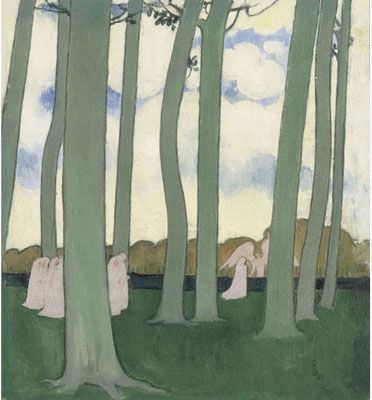
Landscape with Green Trees
Also known as Beech Trees in Kerduel, this is one of Denis's best-known paintings, an exemplary work of the Nabi group which nonetheless expresses his unique spiritual concerns, this painting shows a group of trees - or rather, a group of elegantly extended green trunks, their branches cut off by the idiosyncratic framing of the piece - set against a cloudy, white sky. The strong verticality of the composition is counterbalanced by the horizontal, dark green ground, and by a low wall picked out in a still darker green, set in the background of the composition. Between the trees flit mysterious, robed figures; a winged figure in white can be made out behind the background barrier.
The composition of this piece achieves a fine degree of formal and tonal balance exemplary of the Nabis' approach, and of the inherited concerns of Symbolism. According to curator Jane Kinsman, Denis implemented Gauguin's advice on responding to nature through art: "Do not copy too much after nature; art is an abstraction - draw it from nature by dreaming in front of it, and think more about the creation than about the result." The result in this case is a painting whose simple, clearly defined, complementary shapes and colors perfectly express the Nabis' concern with capturing the inner mood and emotional content of a landscape. At the same time, the piece expresses Denis's unique interest in representing themes of Christian love. One of the robed women seems to have left the group to communicate with an angel: perhaps an allegorical representation of Mary answering the call of God, or a more general representation of Christian conversion. In other works of this period, including several portraits of his wife Marthe, Denis would explore similar themes more indirectly, by depicting the interplay between romantic and Christian love. At the same time, once we are aware that the Forest of Kerduel mentioned in the title of this piece was a legendary domain of King Arthur, the piece also takes on clear resonances with Breton Folklore, showing Denis's ability to combine Christian and mythical iconography in his work.
This painting is a significant work in the development of the Nabis' style, and thus in the development of modern art in general during the late nineteenth century. It shows Denis's ability to combine the Nabis' emphasis on capturing the emotional and spiritual content of a landscape with his personal religious concerns, and, like all his work from this period, predicts the ever-more exaggerated flattening of the picture plane which would define the development of modern art over the next few decades. This painting was highly valued by its creator, and Denis kept it all his life, even claiming it back from the Galerie Druet in Paris at one point, having briefly dedicated it to the museum and then changing his mind.
Oil on canvas - Musée d'Orsay, Paris
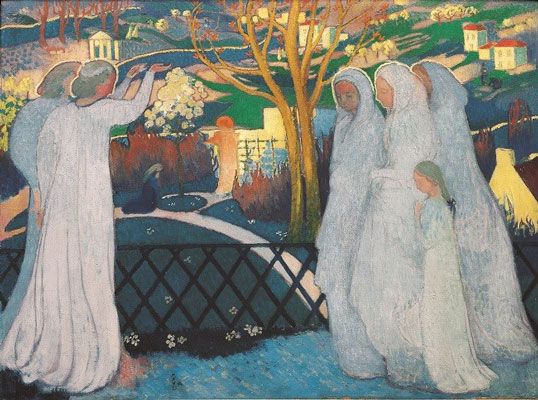
Easter Morning
The work depicts a group of woman, clothed in white robes and piously composed, walking in a garden. They are accompanied by a child, and by two angels who hold their hands up in a gesture of protection. In the background is a vivid landscape, perhaps Italianate, yet strangely otherworldly, composed of small whitewashed houses dotted along a green hillside.
Easter Morning (also known as Holy Women at the Tomb) exemplifies the evermore pronounced integration of Christian allegory into Denis's work; unlike in Landscape with Green Trees, these themes are not ambiguously or ephemerally expressed. In fact, the title of the work indicates that the women are approaching the tomb of Christ on Easter Morning, in which context the beauty of the landscape comes to stand for the beauty of the women's souls, and of their spiritual devotion. Other paintings produced around this time focus on similar themes, including the Annunciation, the Madonna and Child, the Last Supper, the Crucifixion, and the Resurrection. The increasingly direct expression of Christian faith through Denis's work would lead him away from the rest of the Nabi group, and thus away from some of the central concerns of modern art. But his themes were only those that had shaped European Art for centuries. In this sense, Denis was simply proceeding along the course of "Neo-Traditionalism" laid out in his Nabi manifesto of four years earlier.
Oil on canvas - Saint-Germain-en-Laye, Musée Départemental
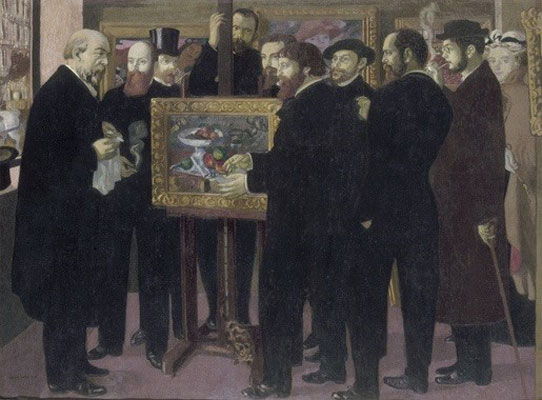
Homage to Cézanne
In this work, set in the shop of the art dealer Ambroise Vollard, a group of painters discusses Paul Cézanne's seminal work Still Life with Fruit-Dish (1880). In the foreground, to the left of the Cézanne painting, Odilon Redon - with handkerchief - looks over at Paul Sérusier, standing to the immediate right of the canvas, who seems to be offering an explanation of the work to his older colleague. The other figures who make up the scene, positioned behind the painting, are, from left to right: Édouard Vuillard - with cigarette in hand - the critic André Mellerio - with top hat - the dealer Vollard - behind the easel - Denis himself, Paul Ranson, Ker-Xavier Roussel, Pierre Bonnard - smoking a pipe - and, finally, Denis's wife Marthe Meurier, the only figure to address the viewer with her gaze (perhaps subtly undercutting the pomp and ceremony of the scene).
As the title of the painting suggests, it pays loving tribute to Cézanne, an artist of an older generation - born in 1839 - whose bold experiments in distorting and manipulating the picture plane had predicted almost all the significant developments in French painting since Impressionism. For Denis, Cézanne was the Master who moved beyond the hyper-naturalistic concerns of Impressionism to define a more analytical - Denis called it Neo-classical - method of painting, emphasizing the flatness of the canvas, reducing forms to elementary shapes, and emphasizing their depth and solidity using the modelling effects of color contrasts. Showing a group of younger artists vigorously discussing one of Cézanne's best-known works indicates that group's sense of his visionary significance. At the same time, Denis indicates the debt that his generation owes to Redon, a Symbolist painter also of an older generation - that of Gustave Moreau and Pierre Puvis de Chavanne - whose organic abstractions, and concern with the emotional content of landscape, visions and dreams, also prefigured the advances of the Nabis. Paintings by two other older painters - Paul Gauguin and Pierre-Auguste Renoir - hang on the walls of the shop.
In suggesting his generation's indebtedness to these pioneering figures, Denis signals the relationship between experiment and heritage which determined the progress of modern art. At the same time, in announcing that debt, Denis ironically returns to a more traditionally figurative form of painting, reflecting the unique extent to which his own work - though unmistakably modern in its formal traits and cultural connotations - would enact a return to inherited themes, cultural forms, and stylistic approaches.
Oil on canvas - Musée d'Orsay, Paris
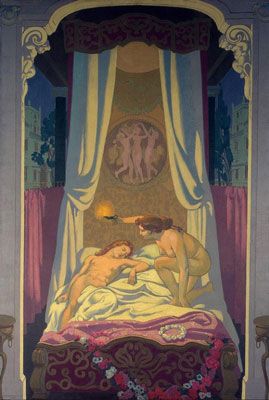
Psyche Discovers that Her Mysterious Lover is Eros
This painting is one of 13 panels (collectively entitled The Story of Psyche) commissioned by the Russian art collector Ivan Morozov for the concert room of his Moscow mansion. For this large series of narrative paintings, Denis chose a mythological theme, responding to an ancient Greek story of two divine lovers, Psyche and Cupid, which explores the same connections between romantic love and spiritual faith often explored in Denis's painting.
The Story of Psyche panels indicate Denis's clear movement, later in his career, away from the abstracted organic shapes of the Nabis, and towards the use of conventional three-dimensional perspective and clearly defined human figures. That said, the paintings' vibrant color palette reflects Denis's ongoing interest in using color to convey the emotional and spiritual mood of his subject. The painting also shows Denis's increasing debt to classical art, since a series of formative trips to Italy in 1895, 1897, and 1898. In particular, the supple physical beauty of his protagonists - whose bodies are almost statuesque in their elegance, and stylized postures - reflects the influence of Raphael and Michelangelo, two artists whose work Denis had seen in the Vatican in 1898. By offering a synthesis between Classical art and the stylistics of Symbolism and the Nabis, Denis defined a new form of religious painting for the twentieth century. In its composition for a domestic setting, meanwhile, the panels indicate his increasing interest in integrating the fine arts with architecture and interior design, influenced both by Japonism and the Art Nouveau movement.
Denis famously stated that "what is naked is chaste, what is naked is beautiful", and in their intimate depiction of the human body, the Story of Psyche paintings predict the increasing incorporation of nude figures into Denis's work from the 1910s onwards. In many cases, this nudity alluded to a pure, primal condition of humanity, wherein the spiritual dimensions of the soul, and the natural innocence of humankind, remained untouched. In this case, however - perhaps because of the narrative context of the scene - nudity is charged with a strong eroticism.
The Story of Psyche shows a mature artist confident enough in his personal vision to step back from some of the formal advances that had initially ensured his reputation, enacting a return to certain aspects of artistic tradition while retaining some of the stylistic lessons of the recent past. The fact the Morosov commissioned the panels in response to his rival patron Sergei Shchukin's impressive Matisse collection indicates Denis's stature in the art world by the close of the 1900s. That stature was confirmed by the euphoric reception of the first seven Story of Psyche panels, after which Morozov changed his plans to hire Matisse to decorate his dining room, instead commissioning six more panels from Denis. If the older painter won this battle, however, he lost the war, as his thirteen panels were eventually covered over with Matisse works.
Oil on canvas - The State Hermitage Museum, St. Petersburg
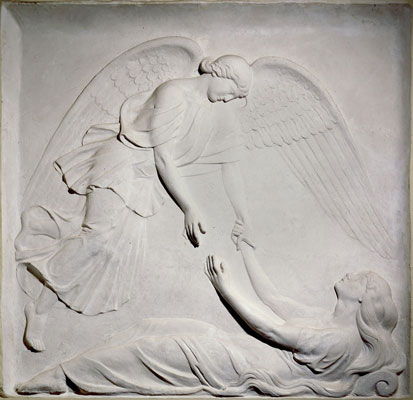
Monument Jamot
This sculptural relief shows a body, lying on the ground, drawn up to heaven by an angel. The work was commissioned by Paul Jamot, art historian and curator of the Louvre, who wanted a monument for his wife Madeleine, who had died prematurely in 1913. The project was undertaken in collaboration with the architect Auguste Perret and overseen by Jamot himself, who wanted a piece that would emphasize the immortality of the soul, evoking the process of death and resurrection. A few years later, Jamot would turn to Denis again for a commemorative work, commissioning him to create a series of illustrations for a book of poems, Una (1924), also dedicated to his wife.
The Jamot Monument is exemplary of Denis's later body of work in its devotion to religious themes. Denis envisioned the touching of hands between the angel and Madeleine as the central feature of the work, emphasizing the continuation of human life after death. In this sense, the piece reflects Denis's belief that art should "inscribe our poor and lamentable life of suffering" with hope. The work draws its inspiration from a whole range of artwork on the theme of Resurrection produced since the Early Renaissance, including Fra Angelico's Resurrection of Christ and the Women at the Tomb (1440), Giovanni Bellini's The Resurrection (1475) and, more recently, Nikolai Ge's proto-Symbolist work Harbingers of the Resurrection (1867).
In formal terms, though the work is sculptural, it exemplifies the methods of Denis's later painting, with the stylization and simplification of human forms counterbalanced by a more traditionally naturalistic approach than is evident in Denis's youthful work. The expression and body language of the human subjects, meanwhile, conveys various archetypal emotional and spiritual conditions.
Stone carving - Montparnasse Cemetery, Paris
Biography of Maurice Denis
Childhood
Maurice Denis was born on November 25, 1870 in the coastal town of Granville in Normandy, where his parents had moved to escape from the Franco-Prussian War; though they would later return, with their only child, to the house of Saint-Germain-en-Laye, in the cozy suburbs of Paris. Maurice's father worked as a railway company official, and his mother was a milliner and seamstress.
Raised in a catholic household, Denis was informed by religious feelings, and by a passion and talent for art, from an early age. As a teenager, he often visited churches and cathedrals, and came to admire the work of Fra Angelico; at the age of thirteen, he began to take drawing classes, making sketches from the Old Masters in the Louvre. By the age of fifteen, he was writing it his diary: "Yes, it is necessary that I am a Christian painter, that I celebrate all the miracles of Christianity". Coming from a well-off family, Denis received a classical education at the Lycee Condorcet, one of the most prestigious high schools in Paris, where he met fellow artists and future Nabis Édouard Vuillard and Ker-Xavier Roussel. By all accounts, Denis was an excellent student, receiving numerous distinctions, but in 1888 he left the school to enroll at the Académie Julian, the private art school of the painter and teacher Rodolphe Julian, which had produced many notable painters across the nineteenth century; the following year, Denis was accepted into the prestigious École des Beaux-Arts.
Early training and work
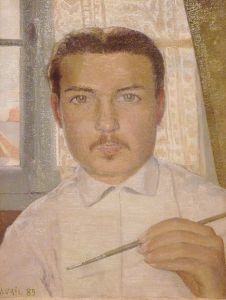
At the Académie Julian, Denis studied alongside his old school friends Vuillard and Roussel. He also befriended two artists who would go on to be centrally involved in the formation of the Nabi group, Pierre Bonnard and Paul Sérusier. At this time, Denis was deeply influenced by the Symbolist movement, in particular the work of Pierre Puvis de Chavannes, which he had first seen in an 1887 exhibition, and Paul Gauguin, whose first exhibition at the Café Volpini in 1889 was a revelation to Denis. One day in 1888, Sérusier showed his friends at Julian a painting he had made under the guidance of Gauguin earlier that year in Pont-Aven, a district of rural Britanny which had hosted various artists' groupings since the 1860s, and where the older painter, Gauguin, had based himself intermittently since 1886. Denis and his friends were so amazed by Sérusier's work - a small landscape painted on the back of a cigar-box - that they formed an artistic movement based on the new artistic vision which it seemed to capture, naming themselves, after the Hebrew term for "prophet", "Les Nabis". They accorded such power to Sérusier's particular painting that it became known as The Talisman. Following Gaugin's example, this group of young French painters, including Sérusier, Denis, Bonnard, Vuillard, Roussel, and others, freed themselves from the task of meticulously representing visual sensation which had preoccupied French art since Impressionism. Instead, they attempted to capture the spiritual and emotional content of their subject-matter - often of landscapes - giving their work a spiritual flavor preempted in certain respects by Symbolist painting. Rejecting ideas of linear perspectives and modeling, the Nabis also drew inspiration from the decorative arts and - partly via Gauguin - from Japonism, then approaching the height of its fashion in Europe.
As well as producing a series of highly experimental paintings during the late 1880s and early 1890s, Maurice Denis quickly established himself as the most eloquent theorist of the Nabis. His first article on the new style, "Definition of Neo-Traditionalism", was published in Art et Critique in 1890, and was taken as a kind of manifesto for the group. In it, Denis rejects Impressionism's obsession with naturalistic accuracy, and defends the idea of the spiritual function of art. His famous opening quote established the Nabis as the forerunners of all subsequent experiments in pictorial abstraction over the next half-century: "Remember, that a picture, before it is a picture of a battle horse, a nude woman, or some story, is essentially a flat surface covered in colors arranged in a certain order.".
Mature Period
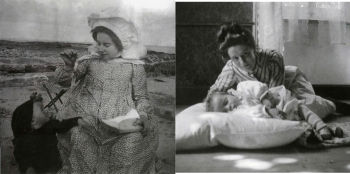
Denis was nicknamed the "Nabi of the beautiful icons", because of his compulsion towards a kind of religious iconography informed by his Catholicism, very different from the unorthodox or theosophical Spirituality which influenced other members of the Nabi group. Nonetheless, between 1888 and 1893, Denis exhibited many times with the other group members, and during this period, a commonality of approach remained. In June 1893, Denis married the musician Marthe Meurier, having completed many portraits of her, and proclaimed his love for her repeatedly in his diaries, since meeting her in 1890. Love, spirituality, religion, Marthe: these were Denis's preferred subject-matters during the early days of the Nabis, and they would remain so for the rest of his life. In the mid-1890s, Denis became more influenced by the decorative arts - already a key influence on the Nabi movement, which placed a stress on 'style' absent from the Impressionist credo - in line with the advent of the Art Nouveau movement in Brussels and Paris. Denis was interested in the interplay between art, architecture, and design, particularly in religious settings, and undertook various commissions to decorate churches and private houses, while increasingly incorporating purely decorative features into his paintings. He also explored various strands of commercial design, devising patterns and models for carpets, ceramics, stained-glass windows, screens, and fans. Denis made illustrations for books by Symbolist writers, including an edition of Paul Verlaine's Sagesse, and frontispieces for musical scores, notably for Claude Debussy.
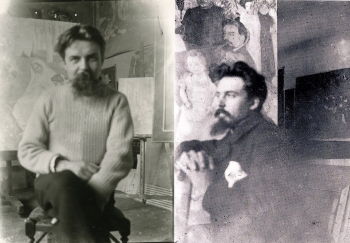
Trips to Italy in 1895, 1897, and 1898 would play an important part in Denis's life and artistic development, taking his work in a new direction that increasingly isolated him from the Nabis. From this time onwards, this work began to show the influence of Italian Renaissance masters such as Raphael and Michelangelo more clearly. By the late 1890s, in any case, the Nabis - who were never a movement in the true sense, more a loose association of like-minded individuals - had already drifted apart, and Denis began to distance himself from his former friends. From Rome, he wrote to Vuillard about the importance of classicism and of Raphael, eliciting a shocked and negative response from his old friend.
During his 1898 trip to Italy, Denis met up with his friend the writer Andre Gide, a sometime collaborator, and an ardent defender of Classicism. Their discussions shored up Denis's belief in the necessity of a return to Classical principles in art: as the critic Gerard Vaughan notes, "both the writer and the visual artist played important roles in the creation of French Neo-classicism and both came to regard France as the natural heir to Greek and Roman antiquity". Denis was also a great admirer of Cézanne, who had rejected Impressionism's emphasis on the interplay of color in favor of a compositional approach based on the depiction of solid, sculptural forms; Denis considered Cézanne the true founder of contemporary Neo-classicist art.
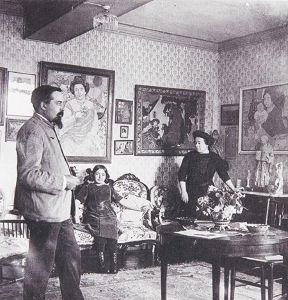
In the tumultuous socio-political context of early twentieth-century France, championing Catholicism also had its political resonances. Denis was drawn towards the case for the prosecution in the Dreyfus Affair, when a young French Army Officer of Jewish extraction, Alfred Dreyfus, was twice falsely convicted of treason. If this lined Denis up alongside the forces of conservatism and antisemitism in late nineteenth-century French society, his connection from 1904 to 1927 to the ultra-right-wing political movement Action Francaise, which emerged from the ashes of the collapsed Dreyfus case, confirmed his allegiances. Denis's reputation as an avant-garde artist was somewhat tarnished by these associations, but his position as a critic and theorist remained strong. When Henri Matisse emerged as the leading exponent of Fauvism, an artistic movement focused on capturing the vibrancy of color which was, in a sense, the natural inheritor of the Nabis' approach, Denis became his most outspoken critic, disparaging Matisse for an overly-theorized avant-garde approach. He criticized Matisse's famous 1905 painting Woman in Hat, for example, for its lack of emotional content, and the rivalry between the two painters would also be played out in the competitive world of Russian art patronage, with the famous collectors Ivan Morozov and Sergei Shchukin stockpiling Denis and Matisse works across the 1900s-10s.
Late Period
When Denis was forty-one, his father died, an event that had a great personal impact on the artist. In 1914, he bought the former hospital of Saint-Germaine-en-Laye, renaming it The Priory and renovating the building with frescos and stained-glass windows, a task which preoccupied him until 1928.

In 1919, after twenty-six years of marriage, Denis's wife passed way. Heartbroken, he painted a chapel in her memory. The same year, he founded the Ateliers d'Art Sacré (literally "Workshops of Sacred Art") with Georges Desvallières. The aim of this group was to reconcile religious faith with modern culture by producing art for religious settings - churches, cathedrals - which would dispense with the academicism and realism of previous approaches to such work, and to train a new generation of religious artists and craftsmen. The group renovated several churches between 1919 and the mid-1930s, when a lack of commissions forced them to disband. Amongst their most notable commissions was a set of paintings for the Église du Saint-Esprit in Paris, completed in 1934. Although Denis's work from this period was profoundly influenced by his faith, he also produced murals for civic buildings across the 1920s-30s.
In 1921, when Denis was 51 years old, he returned to Italy with one of his daughters. On this trip he met Elisabeth Graterolleore, whom he would marry the following year. The first of Maurice and Elisabeth's two children was born in 1922. Between 1936 and 1939, Denis created several decorative panels for the Palais des Nations in Geneva. Already well-regarded as a painter and decorative artist, towards the end of his life Denis published several important articles on aesthetics.
Denis continued to paint prolifically in his old age: in total, he finished over twenty mural projects between 1916 and 1943. That year, still involved in various creative and academic projects, Denis was run over by a car, and died on the way to the hospital.
The Legacy of Maurice Denis
Maurice Denis was a vital figure during the transitional period between Impressionism and the radical abstraction of early twentieth-century modern art. Although by the end of his life he was chiefly known as one of the most respected art critics in Europe, today he is generally regarded as the last 'Great French Painter' still awaiting rediscovery.
Denis was an influential figure within several overlapping artistic movements of the late-nineteenth century: Symbolism, Post-Impressionism, Japonism, Neo-Traditionalism, Neo-Classicism, and Synthetism. His work of the 1880s-90s, and his iconic manifesto of 1890, anticipated the move towards pictorial abstraction that would become the fundamental feature of modern painting from Cubism onwards, while his students included the post-Cubist and Art Deco painter Tamara de Lempicka, who credited him with teaching her "the craft of painting". At the same time, Denis stands out for his advocacy of tradition - both artistic and cultural - in an era often defined by its radical antipathy to the past. In his "Definition of Neo-Traditionalism", he had proclaimed that "everything is contained in the beauty of the work", emphasizing a timeless ideal of beauty which set his approach apart from the "progressive" formalism of Neo-Impressionists such as Georges Seurat.
As both a devout Catholic and a modern artist of great vision and skill, Denis also helped to redefine Religious art, bringing it back to the forefront of creative advances in the visual and decorative fields, a position it had arguably not occupied since the era of Da Vinci and Michelangelo. Denis's influence in this regard can be sensed in the spiritual approach of many subsequent modern artists, including Wassily Kandinsky, whose hugely influential tract Concerning the Spiritual in Art (1911) might not have been written without the formative example of Denis's theories. Subsequent modern art groupings, from the De Stijl movement of 1910s Holland to the Abstract Expressionist movement of 1950s New York, also took their cue in part from the Denis's conceptual integration of visual abstraction and spiritual expressiveness. In this sense, Denis's influence on the story of modern art - or at least the influence of the ideal for which he stood - can be sensed almost everywhere.
Influences and Connections

-
![Paul Sérusier]() Paul Sérusier
Paul Sérusier -
![Pierre Bonnard]() Pierre Bonnard
Pierre Bonnard ![André Gide]() André Gide
André Gide- Jacques-Emile Blanche
-
![Paul Sérusier]() Paul Sérusier
Paul Sérusier -
![Pierre Bonnard]() Pierre Bonnard
Pierre Bonnard -
![Édouard Vuillard]() Édouard Vuillard
Édouard Vuillard ![Paul Ranson]() Paul Ranson
Paul Ranson![Ker-Xavier Roussel]() Ker-Xavier Roussel
Ker-Xavier Roussel
-
![Les Nabis]() Les Nabis
Les Nabis -
![Fauvism]() Fauvism
Fauvism -
![Cubism]() Cubism
Cubism -
![Neoclassicism]() Neoclassicism
Neoclassicism ![Synthetism]() Synthetism
Synthetism
Useful Resources on Maurice Denis
- Maurice Denis: Le Spirituel Dans l'ArtOur PickBy Jean-Paul Bouillon / 2006
- Symbolist Art Theories: A Critical AnthologyOur PickBy Henri Dorra
- Maurice Denis: Earthly Paradise (1870-1943)Our PickBy Jean-Paul Bouillon, Sylvie Patry and others
- Beyond the Easel: Decorative Painting by Bonnard, Vuillard, Denis, and Roussel, 1890-1930By Gloria Groom, Nicholas Watkins and others
- The NabisOur PickBy Albert Kostenevitch
